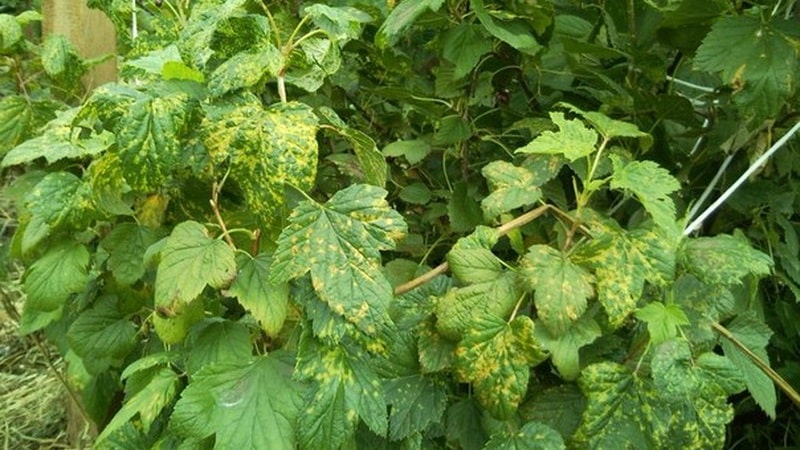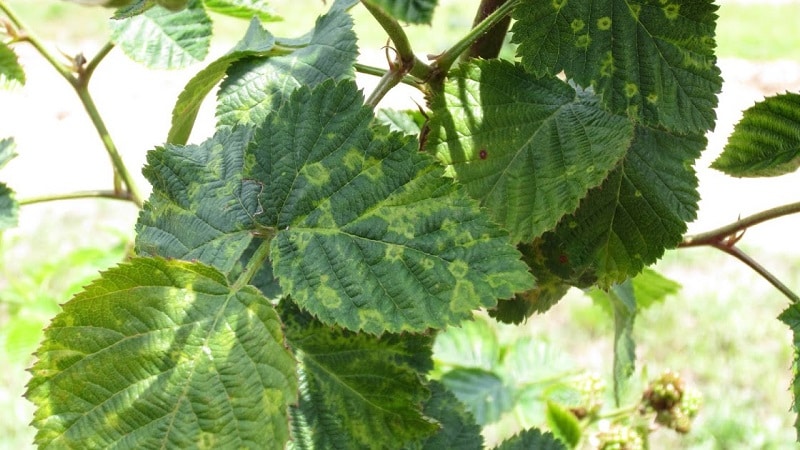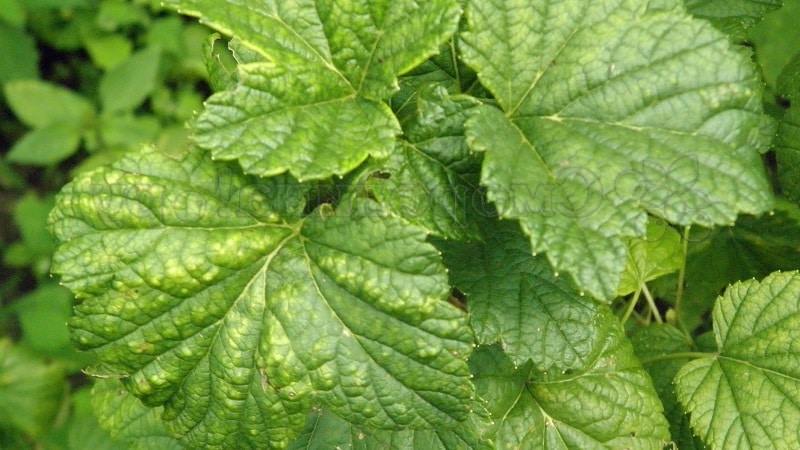Why is mosaic on currants dangerous and how to get rid of it?
Disease control is an essential stage of currant care. If you do not carry out preventive and therapeutic measures, you may not wait for the harvest. One of the most dangerous diseases is currant mosaic. The disease is characterized by suddenness and is difficult to cure. What to do with mosaic on currants and what products to use for mosaic therapy, you will learn from the article.
What kind of currant disease is this - mosaic
Mosaic - common viral disease garden shrubs, including red, green and black currants. It affects young and adult plants at any stage of the growing season.

Pathogens and distribution
The causative agents of the disease are viruses. A mosaic appears as a result of damage to chloroplasts. Cellular structures break down, which leads to a significant decrease in carbohydrate levels. As a result, areas of tissue die and the first symptoms of infection appear.
Mosaic virus spreads due to mechanical damage to currants, for example, when pruning mature bushes or picking seedlings. The disease is transmitted through contact between healthy and diseased plants and spreads with wind and precipitation. Another carrier of mosaic are garden pests: aphids, bugs, ticks and other insects. In addition to them, the virus is transmitted through fruits and seeds carried by birds and animals.
Attention! Often the source of the virus is garden soil.Last year's weeds, plant debris and fallen leaves remain in it. Therefore, before planting bushes, gardeners remove all debris from the site, burn it and monitor the cleanliness of the soil in the future.
Damage caused
If a mosaic appears on seedlings, the plant slows down its growth and development. If it is on an adult bush, the currant’s immunity weakens, the harvest disappears, and the plant itself gradually dies. It is impossible to restore such a bush; it is removed from the site and burned.
The difficulty is that the symptoms do not appear immediately, and before characteristic spots appear on the bushes, all neighboring fruit trees and shrubs may be infected with this virus.
Types of mosaics
There are several types of currant mosaic - striped and interveinal white. Striped (veined) mosaic appears on the site due to aphids and mites or as a result of vaccination of the patient cuttings on a healthy bush.
Large bright yellow patterns are formed on the leaves, the veins are clearly visible. The peculiarity of the disease is that it cannot be treated - the bush is uprooted from the garden plot and burned, and the soil and remaining plants are treated with a solution of copper sulfate or pesticides.
Interveinal white mosaic affects red currant varieties. Sick bushes are stunted in growth, gardeners notice a faded color of leaves and shoots. The virus is transmitted by the sap of infected bushes, as well as by the wind.
Mosaic leaves are covered with blurry light yellow or white spots, the color of which becomes more intense every day. If detected early, interveinal white mosaic can be treated with chemicals.
Causes
Reasons for the spread of mosaics - non-compliance with planting rules and errors in agrotechnical measures. For example, currants are easily infected during cutting timewhen the pathogen gets into small wounds and cracks.
High humidity and air temperature above +25°C contribute to infection. Most often, the virus infects weakened plants with a deficiency of microelements. The bushes have weak immunity and do not have the strength to resist the virus. Therefore, lack of fertilizer is another cause of infection.
Symptoms and external manifestations of currant damage
Characteristic sign - the appearance on the leaf blades of white or yellow spots of the same different size and shape. Because of the virus, metabolic processes are disrupted - currant growth slows down, shoots lose vitality and slowly dry out. If the bush is tall, with a lush crown, it quickly withers.
If the mosaic overtook the currants in the middle of summer, when the berries have already appeared, they become deformed and fall to the ground. The fruits lose their presentation, taste and beneficial properties. It is not recommended to eat them - due to the virus, they slowly rot from the inside.

How to treat currants for mosaic
To treat currants, gardeners use chemicals, folk and agrotechnical methods.
It is recommended to combine them with each other to achieve the effect quickly and preserve the harvest.
Chemicals
A popular remedy for treating currants is “Tiovit Jet”. The drug combines the properties of a fungicide, acaricide and fertilizer, and is used to treat various currant varieties. To prepare a working solution, 20 mg of the product is diluted in 10 liters of water and 5 liters are consumed per 1 square meter. m. Gardeners process currants three times with an interval of 10 days. In addition to treating mosaic, Tiovit Jet protects berry bushes from aphids, mites and fungal diseases. Sold in water-soluble granules.
For the treatment and prevention of striped mosaic, use the systemic fungicide "Horus". To prepare, 2 g of the drug is dissolved in 10 liters of water and spray currants at the rate of 1 liter of liquid per 10 sq. m. After processing, some of the substances remain in the upper layer of plant tissue, which protects the currants from the penetration of the virus. The first time “Horus” is used before flowering, the second time - after 5-10 days.
Attention! Currants are processed on a windless day, in the morning or evening. The optimal temperature is about +20°C. Before the procedure watering the currants and remove weeds. There should be no grass or leaves near the bushes.
Agrotechnical techniques
Agrotechnical techniques are not able to rid currants of the virus, but they enhance the effect of chemicals and serve as prevention the appearance of the mosaic. One of the methods is the timely destruction of plant residues.
Currants do not like dense plantings and do not tolerate weeds, which take away some of the nutrients from it. Because of this, the bush weakens and becomes more susceptible to viruses and other microorganisms. Therefore, plantings are regularly weeded and loosened - the procedures nourish the soil and improve oxygen circulation.
Mandatory agrotechnical practices in caring for currants — preparation and disinfection of planting material. Currant seedlings are purchased in autumn or spring, depending on the planting date. Seedlings should be flexible and light gray in color. The buds are not swollen; each seedling has about 3-4 young shoots. After purchase, the roots are wrapped in a damp cloth, and the planting site is disinfected with a solution of potassium permanganate or watered with boiling water. Only after this are the currants planted on the site.
Traditional methods
Traditional methods used to treat mosaics at an early stage of infection. They are good because they require improvised means for preparation.
Treat currants with iodine solution - 10 ml is diluted in 10 liters of water. During the season, 3-5 treatments are carried out with an interval of at least 10 days. In addition to mosaic, iodine solution rids berries of powdery mildew and root rot, which develops as a result of high humidity.
Ammonia is used for treatment and prevention. In 10 liters of warm water, dilute 40 ml of ammonia and add 50 g of grated laundry soap. The product has a pungent odor, but it dissipates quickly. After treatment, the currants are not watered for 2-3 days. A solution of ammonia prevents the development of insect pests that carry the mosaic virus throughout the garden.

Features of the treatment of black, red, white currants
To save red currants from interveinal white mosaic, gardeners use a proven method - treatment with Bordeaux mixture. It does not cause burns to plants, acts quickly and is safe. 100 liters of liquid are diluted in 10 liters of water and about 1.5 liters are poured under each bush. Treat the bush every 2 weeks. In addition to the therapeutic effect, the treatment strengthens the immunity of currants. Contact fungicide is available at any garden store.
Before processing white and black currants, the ground under the bush is carefully loosened. The root system of the crop is located at a depth of 50-60 cm underground. Therefore, it is important that nutrients and microelements penetrate as deep as possible to the roots. Otherwise, the effect of agrotechnical procedures will decrease, and the mosaic will spread to other plants.
Preventive measures
Prevention is the first and most effective means of protecting a plant from a virus. In addition to purchasing a healthy seedling and preparing a planting hole, gardeners use the following measures:
- When planting, garden tools (shovels, rakes, supports) are disinfected with a solution of potassium permanganate. It destroys dangerous viruses and prevents their penetration into the plant.
- In spring, all currant bushes are sprayed with lime mortar. To prepare, dilute 2 kg of lime in 10 liters of water, add 300 g of copper sulfate and mix thoroughly. The base of the bush and all branches are treated with the solution. The solution gets rid of insect larvae that serve as carriers of the disease.
- The place where currants are planted is changed every 7-10 years. This is required by crop rotation rules. Currants are planted at a distance of 1.5-2 m from each other, in sunny and well-ventilated areas.
- In the fall, after harvesting, fallen leaves are collected and burned. Plants are sprayed with a solution of hydrogen peroxide and covered with agrospan.
Resistant currant varieties
When choosing a variety, it is recommended to pay attention to its immunity and resistance to mosaic and other diseases. For landing in the middle lane The medium-late variety Pamyati Pavlova and the productive Ilya Muromets are recommended for Russia. They are easy to care for, frost-resistant, and universal in use.
For cultivation in the northern regions, the varieties Selechenskaya, Ceres, Kupalinka are chosen. They are high-yielding, bear fruit consistently and rarely get sick. And in the southern regions, Bagira and Yadrenaya currants are planted. The plants are drought-resistant and undemanding in care.
Advice from experienced gardeners
The main advice of experienced gardeners is do not wait for the mosaic to appear on the site, but carry out agrotechnical measures and preventive measures in a timely manner.
Currants cannot be called a capricious crop, but they also need regular care.
Summer residents recommend:
- inspect the plant for external signs of infection;
- if detected, begin treatment immediately;
- during processing, spray not only currants, but also shrubs growing nearby;
- loosen and weed the berries to prevent the appearance of pests, including rodents;
- Observe safety precautions when using chemicals.
Conclusion
The causative agent of mosaic is a virus that penetrates inside the plant and slowly destroys it. The disease is easy to recognize by its characteristic pattern - white, yellow or green blurry spots on the leaves.
To combat the virus, chemicals (“Tiovit Jet” or “Chorus”) and traditional methods (treatment with iodine or ammonia) are used. To prevent the appearance of mosaics, currants are loosened, fertilized and weeds and fallen leaves are removed. If the plant cannot be saved, it is removed from the site and burned.